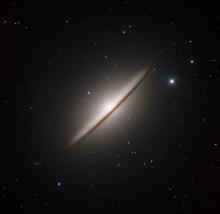Listen to today's episode of StarDate on the web the same day it airs in high-quality streaming audio without any extra ads or announcements. Choose a $8 one-month pass, or listen every day for a year for just $30.
You are here
IC 1101
IC 1101 is the king of the mega-merger. It’s not listed on any stock exchange, though. Instead, it appears to be the biggest galaxy yet seen — a monster that makes the Milky Way look puny by comparison.
All big galaxies get big through a series of mergers. At first, the merging galaxies are fairly small but busy — they’re giving birth to many new stars. As a galaxy grows, however, most of the mergers become one-sided — a big galaxy takes over a smaller one. The Milky Way, for example, probably has gobbled up dozens of small galaxies over the eons.
But a few of the mergers are major — both of the galaxies are big. And that seems to be the case with IC 1101. A study a few years ago suggested that it’s undergone 10 to 20 mergers with other big galaxies.
And that’s made it huge. Its “halo” of gas and old stars may span five million light-years — several times the size of the Milky Way. And the galaxy tips the scales at many times the mass of the Milky Way.
At least part of the galaxy appears to be below average, though. Its middle has far fewer stars than expected for such a giant. And that, too, may be a result of its mergers. Each galaxy involved in the big mergers had a supermassive black hole at its heart. The black holes spiraled around each other, then they merged as well. But the motions of the black holes may have kicked out many of the stars in the center of IC 1101 — a “light-hearted” monster of a galaxy.






